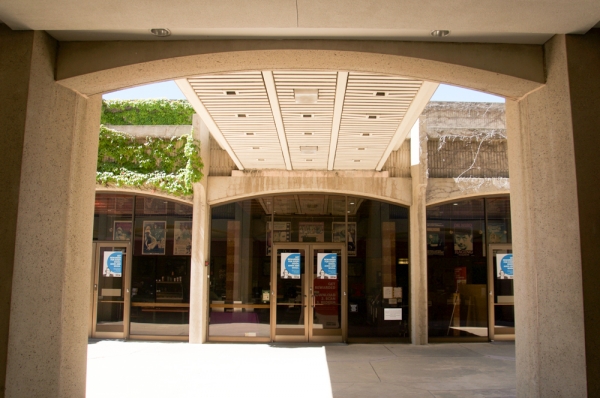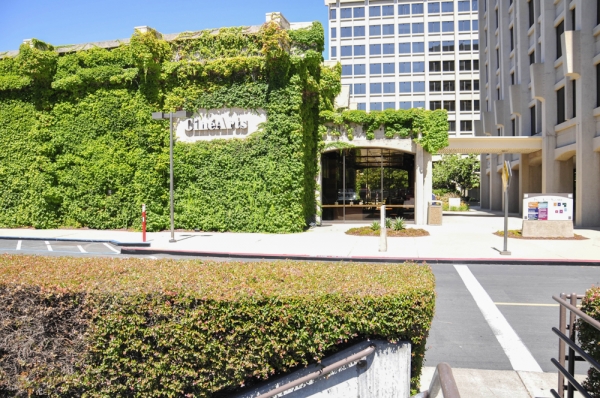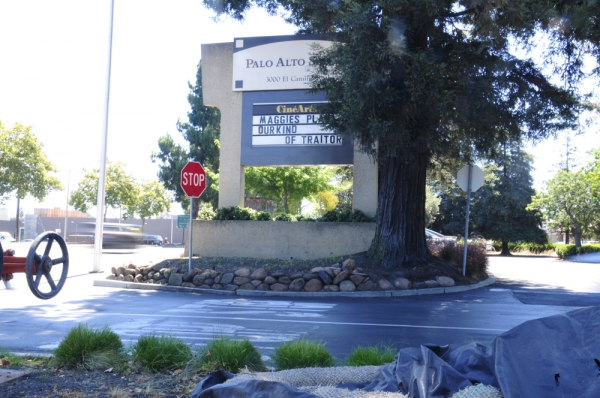With the closure of CinéArts looming over Palo Alto Square, more than 1,600 residents have joined a petition drive that they hope will preserve an amenity they view as a community treasure.
At the same time, city officials are making a case that replacing the theater with a different type of business would constitute a zoning violation, unless the City Council formally approves the change.
The two efforts -- one relying on grassroots democracy and the other rooted in the zoning code -- have the same aim: ensuring that the sprawling office complex at 3000 El Camino Real retains its beloved two-screen theater. CinéArts at Palo Alto Square is one of only three movie theaters left in Palo Alto (one of those three, Stanford Theatre, only shows classic American films).
The petition, launched by a group that includes City Councilwoman Karen Holman, council candidate Lydia Kou, former planning commissioner Arthur Keller and long-time theater proponent Winter Dellenbach, declares the signatories' support for continued operations of CinéArts, which they say "provides a critical part of our cultural and entertainment life in Palo Alto."
As of Wednesday morning, the petition had 1,615 signatures, according to Keller.
"As only one of two first-run theaters in town, the theater provides access to valuable opportunities not otherwise possible in our community, including several prestigious film festivals, such as the United Nations Association Film Festival and the San Francisco Jewish Film Festival, and the popular New York Metropolitan Opera (The MET) simulcasts.
"We urge Hudson Pacific Properties, the management of Palo Alto Square, to encourage and retain CinéArts as its tenant. We urge the City of Palo Alto to work with Hudson Properties and CinéArts management in order to continue the tenancy and operation of CinéArts Theater at Palo Alto Square without interruption."
The decision to close the theater in early August was made by Cinemark, the theater's Texas-based parent company, according to both Hudson Pacific (which manages the property) and the theater chain. James Meredith, spokesman for Cinemark, told the Weekly last week that the lease on the theater was set to expire in late August and making the needed upgrades to the theater was cost prohibitive.
Hudson confirmed the decision was made by Cinemark.
Proposals to close down the theater have popped up twice in the past two decades. In 1997, Palo Alto council members and city staff held frantic, eleventh-hour negotiations with the cinema's former landlord, Equity Properties, to avert the planned closure of what was then a Landmark Theatre.
At the time, the city's then-economic resources director Carol Jansen attributed Equity's ultimate decision not to convert the building to a more lucrative use to the huge outpouring of community support for the theater.
Four years later, when the cinema's fate was once again in jeopardy, the city took a different tack. Though city officials, including former Mayor Gary Fazzino and Economic Resources Manager Susan Arpan, lobbied Equity to preserve Landmark just as officials had in the past, this time they had another card to play: zoning. Unlike in 1997, city staff took the position that a theater was required to be part of Palo Alto Square. When Equity decided not to renew Landmark's lease, Arpan told the Weekly in August 2001: "We do know that it has to be a theater that goes there because of zoning."
Today, city staff is taking a similar position. When asked whether a theater is required rather than simply permitted to be there, Planning Director Hillary Gitelman said staff believes that it is and that the property will need to be rezoned to allow the use of the theater space for any other purpose.
When one looks at the Square's founding documents, however, this position, while consistent with the city's 2001 determination, becomes a matter of debate.
Palo Alto Square was approved in 1969 under the "planned community" (PC) zoning process, and its land use is governed by a specific ordinance for the site, which the council amended in 2001.
Unlike in more recent PC applications, which require developers to provide public benefits in exchange for zoning exemptions, the 1969 ordinance has no such requirement. Back then, projects that sought the PC designation were generally viewed by the council as benefits in themselves.
Thus, in 1969 the theater was not a condition or a requirement for the roughly 300,000 square feet of office space at Palo Alto Square. Instead, the ordinance merely lists "theatres" as one of uses permitted at the site, along with a 300-room hotel and service establishments such as a barber shop, beauty salon, smoke shop-newsstand and gift shop. Nothing in the ordinance suggests that these uses are required, which helps explain why none except the theater ever materialized.
Nor is there any indication that Palo Alto officials considered the theater as either a key benefit or an important condition to the approval of the Palo Alto Square development. Minutes from 1969 indicate that neither the Planning Commission nor the council discussed the theater at any length during public hearings on Stanford University's proposal to rezone the site to a planned community. When Stanford first proposed the zone change in 1965, to enable the financial center, the theater wasn't even mentioned.
Instead, the focus was on promoting commercial development and expanding the city's tax base. Alf Brandin, Stanford's vice president for business affairs, wrote in 1965 that, when developed, the land "should yield substantially greater property tax dollars to all taxing agencies involved, including both the Palo Alto Unified School District and the City of Palo Alto, as well as unusually high sales-tax revenues."
"Since the site is unique for this commercial purpose due to size and location, we do not believe the same financial benefits will accrue to the same agencies if another site is chosen for the facility," Brandin said.
In approving the project, city officials generally agreed the new development "would tend more to uplift than depress nearby areas," as the city's assistant zoning administrator argued at the time. Merchants in the nearby California Avenue also supported the creation of what Palo Alto Square architect Albert Hoover described as a "financial shopping center." Barry Roth, then-president of the California Avenue Area Development Association, told the planning commission in June 1969 that members of his group felt that California Avenue "will probably eventually become a central business area" and that Palo Alto Square "would be a natural complement to the area," according to meeting minutes.
Documents from 1969 indicate that it was Stanford itself, rather than the city, that requested having a theater as part of the complex. Initially, the plan called for two high-rise buildings with a total of 100,000 square feet of space and several one- and two-story buildings with another 100,000 square feet.
In September 1969, however, Hoover proposed a revision. Instead of having 100,000 square feet of office space in the one- and two-story buildings, he suggested 85,000 square feet. This would include 55,000 square feet of "financial space" on the first floor, another 20,000 on the second floor and a 10,000-square-foot theater. The theater building was subsequently included in one of the diagrams that comprise the Palo Alto Square's development plan.
Because that plan was implicitly approved when the council adopted the 1969 ordinance, staff now believes that a zone change is required.
"We view the development plan -- showing the theater -- as the project that was approved under this PC zone," Gitelman told the Weekly. "The PC ordinance does not identify the theater as a 'public benefit' or requirement, but the ordinance would need to be changed (i.e., a rezoning) if the owner wanted to convert that space to other use."
Holman said that while zoning appears to protect the theater, she and others in the community felt it would be important to circulate the petition to demonstrate to Hudson, Cinemark and city staff the community's desire to keep CinéArts in place. Given that the council is in the midst of its summer recess, the public has no real venue for gathering and voicing its concerns. The fact that more than 1,000 people signed the petition in the first 100 hours suggests that keeping CinéArts "really matters to the community."
"It's long known in the community that there is a huge outcry when a cultural resource goes away," Holman said. "This seems to be a way in which we can easily share the information about the theater, make a point that it's critical to the community and ask whoever is making the decision to please reconsider. The issue isn't going to go away."





Comments